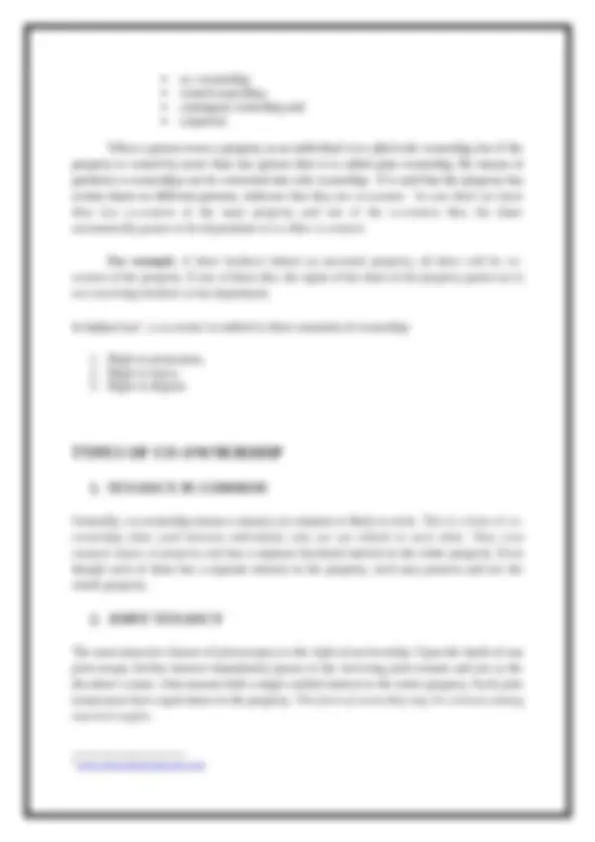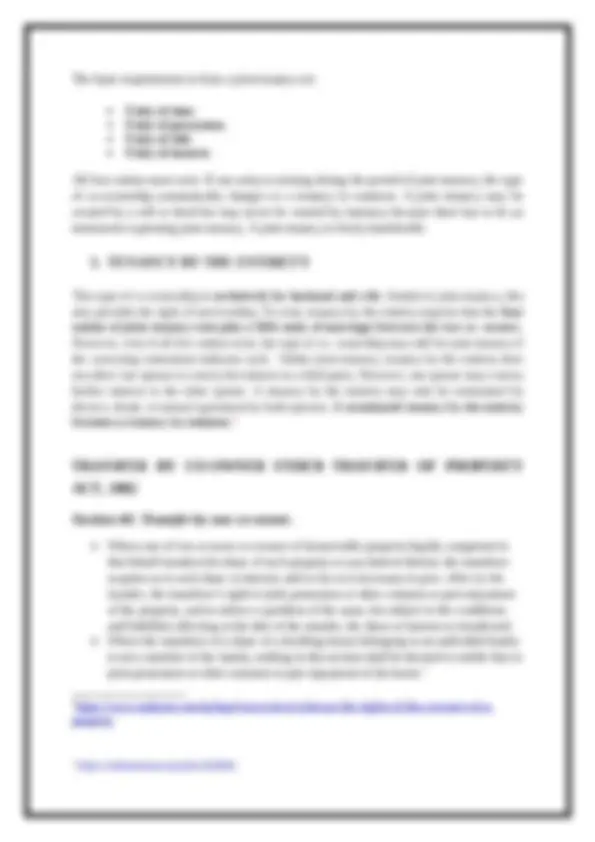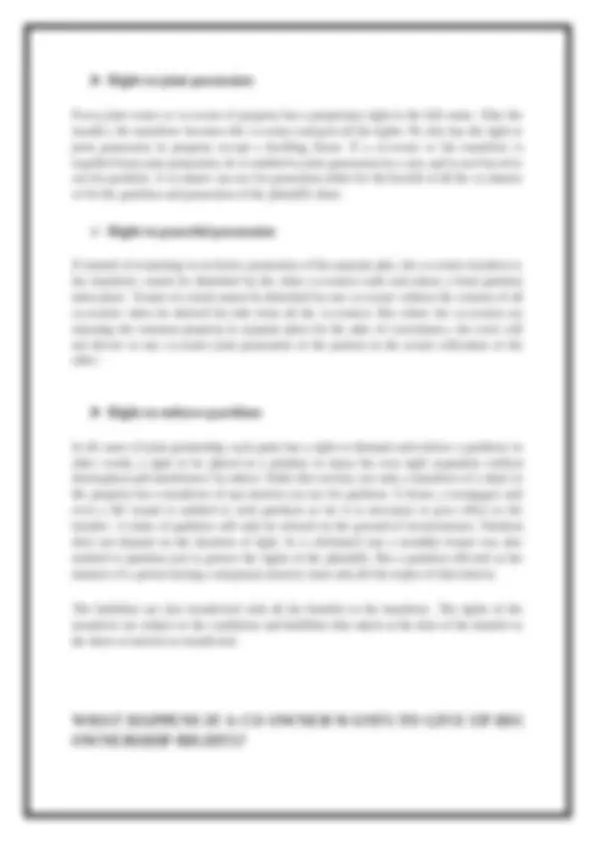








Study with the several resources on Docsity

Earn points by helping other students or get them with a premium plan


Prepare for your exams
Study with the several resources on Docsity

Earn points to download
Earn points by helping other students or get them with a premium plan
Community
Ask the community for help and clear up your study doubts
Discover the best universities in your country according to Docsity users
Free resources
Download our free guides on studying techniques, anxiety management strategies, and thesis advice from Docsity tutors
detailly discuss about the co ownership under transfer of property act
Typology: Study notes
1 / 12

This page cannot be seen from the preview
Don't miss anything!







An immovable property which is jointly owned by two or more persons is called a jointly-owned property and joint owners are often referred to as the co-owners of the property. The co-owners may be the owner of undivided share in the property or of a specified percentage of such jointly-owned property. It is extremely important that at the time of sale-purchase transaction of such jointly-owned properties. The buyer should remain careful and cautious when the property is owned by number of persons. Any agreement to sell, lease, transfer or the sale deed of such jointly-owned property needs to be executed by all the co-owners of the property. However, a co-owner is free to transfer or deal with his part of share of the jointly owned property. In this paper we are going to discuss about the concept of transfer by co-owner in detail along with case laws.
When is a co-owner legally competent to make a transfer and can the co-owner transfer the property without the consent of other co-owners? What are the rights of transferee after the transfer and when does he get the right to ask for partition to use it or sell it? What happens when a co-owner wants to give up his rights?
Owning a property is also one of the factors to indicate the economic status of a person. Generally, property is held by an individual to draw out benefit from it. Transfers are made by owners themselves, ostensible owners and the co-owners or the joint owners. When two or more persons enjoy common ownership of a property, for example say in coparcenary the male members and now even daughters have a common and equal interest in the ancestral property, and the co-owner has right to transfer his share in the property to a stranger or another co-owner. And that transferee acts on the role of the co-owner (transferor) and gets clothed with all his assets and liabilities i.e., the transferee becomes the co-owner. Co-owner simply means two or more persons holding a title or share to the same property.
Ownership consists of many numbers of claims, liberties, powers with regard to the thing owned. Ownership is of different kinds. There are absolute and limited, sole ownership,
The basic requirements to form a joint tenancy are: Unity of time. Unity of possession. Unity of title. Unity of interest. All four unities must exist. If one unity is missing during the period of joint tenancy, the type of co-ownership automatically changes to a tenancy in common. A joint tenancy may be created by a will or deed but may never be created by intestacy because there has to be an instrument expressing joint tenancy. A joint tenancy is freely transferable.
This type of co-ownership is exclusively for husband and wife. Similar to joint tenancy, this also provides the right of survivorship. To exist, tenancy by the entirety requires that the four unities of joint tenancy exist plus a fifth unity of marriage between the two co- owners. However, even if all five unities exist, the type of co- ownership may still be joint tenancy if the conveying instrument indicates such. Unlike joint tenancy, tenancy by the entirety does not allow one spouse to convey his interest to a third party. However, one spouse may convey his/her interest to the other spouse. A tenancy by the entirety may only be terminated by divorce, death, or mutual agreement by both spouses. A terminated tenancy by the entirety becomes a tenancy in common.^2
Where one of two or more co-owners of immoveable property legally competent in that behalf transfers his share of such property or any interest therein, the transferee acquires as to such share or interest, and so far as is necessary to give, effect to the transfer, the transferor’s right to joint possession or other common or part enjoyment of the property, and to enforce a partition of the same, but subject to the conditions and liabilities affecting at the date of the transfer, the share or interest so transferred. Where the transferee of a share of a dwelling-house belonging to an undivided family is not a member of the family, nothing in this section shall be deemed to entitle him to joint possession or other common or part enjoyment of the house.^3 (^2) https://www.makaan.com/iq/legal-taxes-laws/what-are-the-rights-of-the-coowner-of-a- property (^3) https://indiankanoon.org/doc/513068/
It states that if one co-owner of the immovable property transfers his share in the property then the transferee of such share acquires the rights of the transferor which implies that the transferee will be given all the rights of the transferor. Such rights include the right to joint possession and the right to partition to the extent enjoyed by the transferor. However, in case of a dwelling house belonging to an undivided family transferred by the transferee who is not a member of the family in that case he is not entitled to joint possession or other common or part enjoyment of the house. In the case of Durga v. Debidas^4 , the family members were separated and living in different places. They stayed in the house for attending kali pooja. The house was otherwise used for collection of paddies. The Court held that using a property for a short period and for a specific purpose will not make it a dwelling house. Dwelling house is one where there is ancestral dwelling in existence and the family members should have not abandoned the house. In order to grant relief under section 44 there should be two things satisfied- the property transferred should be a dwelling house the transferee should not be a member of the family. In other words, he should be a stranger. The right of a stranger transferee to have the house partitioned is, subject to Section 4 of the Partition Act, 1893. Under this section, a stranger claiming partition by metes and bounds may be compelled, at the option of the other members of the family to forego his legal right to partition and accept pecuniary compensation.^5
This section is based on the principle of subrogation and substitution where the transferee will be bestowed with all the rights of the transferor on the transfer of the immovable property.^6 For example , X, Y and Z mortgage their field to A. Z transfers his share in the field to B. Under this circumstance, B will have the right to joint possession with X and Y and also the right to claim partition however the share acquired by B will still be subject to the mortgage.
(^4) AIR 1974 Cal 14 (^5) Balaji Anant v. Ganesh Janarthan (^6) http://lawtimesjournal.in/transfer-by-co-owners/#_edn
In Rukmini and others v. H.N T. Chettiar^10 it was held by the High Court of Madras that a co-sharer cannot be allowed to cause prejudice to the other co-sharers by putting up a substantial construction during the pendency of a suit for partition filed by the other co- sharers. The High Court of Punjab and Haryana in a case of Hazara Singh v. Faqiria^11 where a co-owner contended that he had, by adverse possession, a peaceful undisturbed possession by the other co-owners had become the sole owner of a land, held that the possession of a co- owner is possession of all the co-owners. It cannot be averse to them unless there is a denial of their right to knowledge by the person in possession. If the entire possession is in the hands of a co-sharer, his possession cannot be deemed to be adverse because he possesses the property on behalf of all others.
The co-owner can alienate his portion only when he has exclusive rights to that portion of the property. If the exclusive rights are not entitled to each co-owner, the consent of other joint co-owners is necessary without which the right cannot be transferred.
Except in case of dwelling house, if any immovable property is transferred, the transferee can ask for the partition of the property to either use it or sell it off. The family who owns the rest of the property cannot oppose the transferee to sell or own the portion he received through the transfer. Basically, section 44 deals with the rights of a transferee and also protects their rights. The transferee steps into the shoes of his transferor i.e., the co-owner, and is entitled to all the rights and becomes subject to all the liabilities of his transferor. In short, we can say that he becomes as much a co-owner as his transferor was before the transfer.
(^10) AIR 1985 Mad 283, (1985) 1 MLJ 142 (^11) AIR 2004 P H 353, (2004) 138 PLR 603
Every joint owner or co-owner of property has a proprietary right in the full estate. After the transfer, the transferee becomes the co-owner and gets all his rights. He also has the right to joint possession in property except a dwelling house. If a co-owner or his transferee is expelled from joint possession, he is entitled to joint possession by a suit, and is not forced to sue for partition. A co-sharer can sue for possession either for the benefit of all the co-sharers or for the partition and possession of the plaintiffs share.
If instead of remaining in exclusive possession of his separate plot, the co-owner transfers it, his transferee cannot be disturbed by the other co-owners until and unless a final partition takes place. Tenant of a land cannot be disturbed by one co-owner without the consent of all co-owners when he derived his title from all the co-owners. But where the co-owners are enjoying the common property in separate plots for the sake of convenience, the court will not decree to one co-owner joint possession of the portion in the actual cultivation of the other.
In all cases of joint partnership, each party has a right to demand and enforce a partition; in other words, a right to be placed in a position to enjoy his own right separately without interruption and interference by others. Under this section, not only a transferee of a share in the property but a transferee of any interest can sue for partition. A lessee, a mortgagee and even a life tenant is entitled to seek partition so far it is necessary to give effect to the transfer. A claim of partition will only be refused on the ground of inconvenience. Partition does not depend on the duration of right. In a celebrated case a monthly tenant was also entitled to partition just to protect the rights of the plaintiffs. But a partition effected at the instance of a person having a temporary interest, lasts only till the expiry of that interest. The liabilities are also transferred with all the benefits to the transferee. The rights of the transferee are subject to the conditions and liabilities that attach at the date of the transfer to the share or interest so transferred.
Facts: P.S. Chouhan held vast properties. He decided to give away the said properties to his 2 sisters (Mrs. Dayabai and Gracebai) and executed a gift deed in 1935 and died unmarried and issueless. There had been no partition between them. Mrs. Dayabai was survived by appellants 2,3and 4. Gracebai is survived by appellant 1, Mrs Lalita Jaems and respondent no. 3. Mrs. Park. The 5.74 acres of land was divided between the survivors of Gracebai. Respondent no. 3 sold her share to Respondent no. 2 for Rs. 14,000/-. After the purchase, the transferee started digging on the land to raise a structure, it was objected by appellant no.1. A suit was filed by the Respondent 2. The Trial Court dismissed the suit as the vendor was not in possession and the sale did not confer any right or title on them and they can get their money refunded. In the First Appeal Court, it was held that the respondent no 3 was in exclusive possession of the land and rightfully sold it to the respondent no 2. Final Judgment: The Madhya Pradesh High Court emphasized that it is the strength of the plaintiff’s title and not the absence of title of the defendant that matters. A purchaser from a co-owner of a portion of undivided property is not entitled to possession of any particular part of the joint property. His right would be for joint ownership and not for exclusive ownership of any particular part of the joint property. A transferee is not in a better position than the co- owner himself. Section 44 gives sanction to this principle. The Respondents will be only entitled to enforce partition of the joint estate. The sale of the exclusive property cannot be accepted. Therefore, the appeal was allowed.
Facts: (^13) AIR 1991 MP 15 (^14) AIR 1992 Cal 44
The disputed property belonged to 4 brothers A, B, C, D. A purchased 1/5th share of D by a deed in 1969. A died in 1975 leaving behind the plaintiffs as his legal heirs. B died leaving four sons and daughters. C is alive and the property is an undivided family dwelling house of the plaintiffs and co-sharers. C and B transferred their interest to the defendants. A monthly tenancy was created in favour of the lessee-defendant and he was also delivered the possession of the same. The Plaintiffs filed a suit under Section 44 to restrain the lessee from interfering with their possession. ISSUE: whether the defendant can interfere with the possession of the plaintiffs? HELD: The court held that the plaintiffs can very well ask for a protection. There is no controversy that the defendant is a stranger to the family. The co-sharer is entitled to protection under section 44. There was enough evidence to show that the house was a dwelling house and that the family was undivided and even the defendant was a stranger. The court relied on various judgments where it was held that upon a transfer of an undivided share of a dwelling house by a co-sharer, the other co-sharer may maintain a suit for injunction to restrain the transferee from getting into possession. Moreover, it was said that a stranger purchaser is reduced to a trespasser. Section 4 of the Partition Act spells out the right to partition of such a stranger. Thus, the appeal was dismissed.
Therefore, where one of the several co-owners transfers his share, the transferee acquires as to such share and so far, as necessary to give effect to the transfer: The transferors’ right to joint possession or other common or part enjoyment of the property, and the transferors’ right to enforce a portion of the same. It should, however, be noted that these rights would be subject to the conditions and liabilities affecting the share so transferred as on the date of the transfer. There is one exception provided under this section which says that where the transfer made is a share of a dwelling house belonging to an undivided family and the transferee is not a member of such family, the transferee shall not be entitled to joint possession. But if the dwelling house has been completely divided and if the transferors’ share has been marked off, so as to be capable of a separate enjoyment, then the transferee can have possession of it. In case of a co-sharer who is in exclusive possession of the jointly-owned property transfers the entire property, the other co-sharers continue to be in constructive possession of such jointly-owned property and continue to be the co-sharers of the property transferred. An undivided share of the co-sharer may be subject matter of sale. But possession cannot be